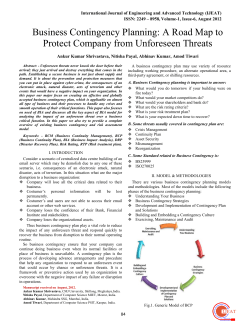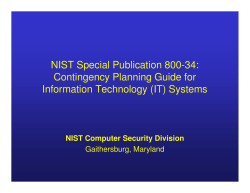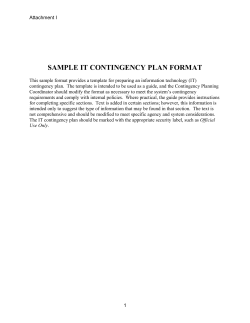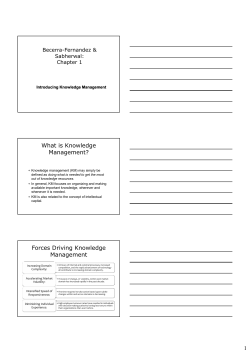
Planning for the Unexpected: Human Resource Risk and Contingency Planning Purdue
Purdue Extension EC-736 Planning for the Unexpected: Human Resource Risk and Contingency Planning Maria I. Marshall and Corinne Alexander Department of Agricultural Economics Small businesses are confronted by many different types of risk: production, marketing, financial, legal, and human. Managers generally spend most of their time dealing with production, marketing, financial, and legal risks and give little consideration to human resource risk and how the absence of key personnel can affect their business. This is a serious oversight because people are the key component in many risk management strategies. Writing a Contingency Plan Human resource risks are events that prevent employees from fulfilling their responsibilities and thus keep the business from operating at full efficiency. Human resource risks include but are not limited to: When writing your contingency plan you should use the knowledge and input of your business’s key employees and outside stakeholders, such as your banker, accountant, insurance agent, and lawyer. You may also want to include family members who are not currently involved in the business but may have a future interest. You should establish a planning team in order to share the responsibility among key personnel. This is important because key employees and other team members will be a critical part of any recovery strategy that you put together. An added advantage of including employees in your planning team is to reassure employees that their jobs are secure even as you are preparing and implementing the plan. • Death • Disability (temporary or permanent) • Divorce • Management Error/Incompetence • Unexpected Temporary Leave • Poor Employee Management Practices • Employee Turnover One way that you can combat human resource risk is by writing a contingency plan. A contingency plan is a structured way of deciding what to do if key operations are disrupted or key personnel are not available. It can help you identify and prevent or modify the impact of unacceptable risks. It helps you recognize the best possible options and ensures that your risk management dollars are spent wisely. A contingency plan is a set of procedures that defines how a business will continue or recover its critical functions in the event of an unplanned disruption to normal activities. It allows you to assess your business operations and processes to determine how well the business can function when key resources, such as critical personnel, are not available. A contingency plan consists of six main sections: • Executive Summary • Risk Management Goals • Risk Assessment • Business Impact Analysis • Risk Management Strategies • Plan Maintenance Writing a contingency plan is a continuous process. Once you decide which risk management strategies make sense for your business, you may need to re-assess the risks in your original plan. You should not be discouraged if this causes you to rewrite several sections. This often leads to an even better understanding of your business and how everyone in it fits together. The executive summary is the first section of your contingency plan. However, it is the last section you should write and so is discussed at the end of this publication. Risk Management Goals In this section, you should identify your risk management goals. The purpose of risk management goals is to reduce uncertainty. For example, you may want to reduce employee absence or accidents, which reduces uncertainty about labor availability. Risk management goals can also be about managing business opportunities. For example, you may want the business or farm to stay within the family, which reduces uncertainty about the continuation of the business. Risk management goals help you decide which opportunities and risk management strategies to pursue. For each event, evaluate both the probability of occurrence and the consequence or impact of occurrence on a scale of 1 to 10, where 1 is low and 10 is high. You can think of the consequence of the event both in terms of severity and cost to the business. The first event in Table 1 is an owner of a business identifying as a possible risk a car accident that prevents or her from fulfilling her normal duties for six weeks. The owner rates the probability of a car accident at between 2 and 3. She rates the consequence of being unable to fulfill her duties for six weeks at 8. Use Worksheet 1 to list the events that pose a threat to your business. Figure 1. The Risk Matrix Risk Assessment This section of the contingency plan is about identifying and assessing the risks to the business. You should pinpoint the events that could cause financial or operational harm to the business. Table 1. Risk Assessment List: What Risks Does Your Enterprise Face? Rate the probability and consequence (severity, cost) of each event on a 1-10 scale (1=Low, 10=High). Event Probability Consequence 1. Owner in car accident, out 6 weeks. . . . . . . . . . . . . . . . 2-3 . . . . . . . . . . . 8 2. Owner, 80, passes away. . . . . 8 . . . . . . . . . . . . 8 3. Owner, 35, passes away. . . . . 1 . . . . . . . . . . . 10 4. New employee quits. . . . . . . . 3 . . . . . . . . . . . . 3 5. Employee injured on farm equipment. . . . . . . . . . . . 5 . . . . . . . . . . . . 5 Purdue Extension • Knowledge to Go Once you have rated the probability and consequences of each event, you can place them all on the risk matrix as shown in Figure 1. In event 2, the owner passes away; he is 80 years old and did not write a succession plan. The owner rates the probability very high at 8 and the consequence also very high at 8. Event 2 demonstrates the importance of succession planning. If the 80-yearold business owner had a succession plan, the consequences to the business would be reduced to around 2. Introducing a succession plan moves the location of event 2 on the risk matrix from high consequence to low consequence, as shown by the arrow. Part of successful contingency planning is to identify areas in which risk management, such as succession planning, is needed. In event 3, a young owner (35 years old) passes away. The owner rates the probability very low at 1, but believes the consequences for the business will be devastating at 10. Event 4 identifies the probability of a new employee quitting at 3 and consequences also low at 3. In event 5, an employee is injured on farm equipment, which is a common occurrence, and the consequences vary greatly, so the owner rates both the probability and consequences at 5. • What are the consequences or impacts on the business (operating, financial, and legal) if that function is not completed? • How long can that function remain deficient? When you think about the recovery timeframe, you should try to determine whether that particular function has to be covered immediately in order to keep the business going or if it can be part of a long-term recovery strategy. You should answer two main questions in this section of the contingency plan: Risk Management Strategies 1.What are the events that could harm my business or reduce my ability to accomplish my risk management goals? 2.On a scale of 1 to 10, how likely is it that the event will occur? Business Impact Analysis You can assess the impact of an event on a business in three ways: operating impact, financial impact, and legal impact. Operating impact is loss of operating efficiency, such as decrease of sales or production volume due to the absence of key employees. It can be as simple as not having someone to answer the phone. Loss of customers, increased costs, and cash flow problems are examples of financial impact. Legal impact involves the inability to fulfill business contracts with suppliers, customers, or vendors. In many ways, these impacts are interrelated. For example, hiring inexperienced temporary personnel to cover the day-to-day duties of an injured business owner might lead to decreased operating efficiency and cash flow problems, which might mean the business cannot pay its vendors, thereby causing a decrease in the business’s credit rating and a lawsuit. Now that you have identified the risks to the business, their probability, and their consequences, you should prioritize and begin to establish management strategies for those risks. As a small business owner, you can decide to retain, reduce, avoid, or transfer the risks you detailed in the risk assessment section. The risk matrix can then guide your choice of risk management strategy. Depending on where the event lies on the risk matrix in Figure 2, there are four corresponding risk management strategies depicted. Use Worksheet 2 to locate the events you identified in Worksheet 1 on the risk matrix. This will help you choose your risk management strategy. Figure 2. The Risk Matrix Guides the Choice of Risk Management Strategy This section also includes identifying critical functions within the business and how the loss of key personnel will affect those functions. You should ask yourself the following questions: • What are the critical functions performed by each individual? • How will the event (loss of key personnel) affect that function? Purdue Extension • Knowledge to Go With a risk avoidance strategy, the business takes action to avoid the risk. Typically, this means the business chooses not to undertake an activity. For example, a farmer may decide not to grow strawberries because she does not have enough reliable labor to pick the strawberries. Event 2 falls into the avoid category; the business owner could avoid the severe negative consequences to the business with a succession plan. A risk reduction strategy requires you to take action to reduce either the probability or consequence of the risk or both. Typical examples include worker safety training and safety equipment, both of which are appropriate measures to address event 5. In the case of event 2, the business owner can invest the time and money to develop a succession plan or will. Unanticipated events will inevitably occur, and, when you choose to retain those risks that are of low consequence to the business, you are choosing a risk retention strategy. Businesses face many small risks, such as a new employee quitting or a customer’s bounced check, and these events are seen as the cost of doing business. You can invest time or money to protect the business when these events occur. A rainy day fund is a common risk retention strategy, saving money when the business is doing well to be able to minimize the impact of customer’s bounced checks and the like. It should also include the procedures to be followed if that event should occur. The main questions to be answered in this section are: • What are the resources required to continue to perform critical functions? • How can the business decrease the likelihood of an event occurring? • How can the business lessen the impact of an event? Executive Summary The executive summary in its basic form should tell the reader who is involved in the plan and what events are considered. It should also summarize the risk management strategies used in the plan. The executive summary is the last thing you write but the first section of the contingency plan. Plan Maintenance It is important that you keep the contingency plan up to date and revise it at least once a year. The plan should reflect any changes in the business. You should identify ways to keep the plan fresh and relevant. Next Steps A risk transfer strategy requires that you transfer the risk to a third party, such as an insurance company. The insurance company will pay an indemnity when the event occurs. Typical insurance options for farmers include crop insurance or revenue insurance. Liability insurance, disability insurance, key personnel insurance, and life insurance are types of insurance that small businesses should investigate. In event 1, the business will be better off if the owner has car insurance and disability insurance. In event 3, the business may survive if the owner’s life insurance provides sufficient cash to allow the spouse or partners to learn how to fulfill the owner’s duties. Use Worksheets 1 and 2 to list your human resource risks and identify your risk management strategies. Then write your contingency plan. Besides human resource risk, you can use a contingency plan to identify risk management strategies associated with production, marketing, financial, and legal risks. Each strategy should include the roles and responsibilities of everyone involved in the recovery stages of an event. We would like to thank the North Central Risk Management Education Center for their support. Purdue Extension • Knowledge to Go Remember that writing a contingency plan is a continuous and evolving process. It can be time consuming but it is the best process to assess the efficiency of your business operations and how well your business can recover from serious disruptions. Acknowledgements Resources Fetsch, Robert J. “From Risk to Resilience in Agriculture: The Human Resource.” Colorado State University Cooperative Extension (Rev.9.049). Goggins, Kelly. (2003). “Contingency Planning 101.” Contingency Planning and Management. Found at www.contingencyplanning.com. Green, Joanna. “Managing People Risks.” Managing Risk. Found at www.agrisk.cornell.edu. Joerger, Paul. (2002). “Profiting from Risk.” Ag News and Views. Found at www.noble.org/ag/Economics. McGrann, James M., Fred DeLano, and Dean McCorkle. (1998). “Farm and Ranch Personnel Management.” Texas Agricultural Extension Service (RM8-1.0). Purdue Extension • Knowledge to Go Scarborough, Norman M. and Thomas W. Zimmerer. (2003). Effective Small Business Management: An Entrepreneurial Approach. New Jersey: Pearson Education, Inc., 632-367. Swigert, Steve. (2003). “Who Is Going to Get the Bulk of Your Estate?” Ag News and Views. Found at www.noble.org/ag/Economics. Taylor, Ben. (2003). “The Big Picture.” Disaster Resource Guide. Found at www.disaster-resource.com/articles/ intro_plan_taylor. United States Department of Agriculture. (1999). “Introduction to Risk Management.” Found at www.rma.usda.gov/pubs White, Jerry. “The Big Five Types of Agricultural Risk.” Found at www.agrisk.cornell.edu. Worksheet 1. What Human Resource Risks Does Your Enterprise Face? Rate the probability and consequence (severity, cost) of each event on a 1-10 scale (1=Low, 10=High). Event Probability Consequence 1. _ ______________________________________ _______________ _______________ 2. _ ______________________________________ _______________ _______________ 3. _ ______________________________________ _______________ _______________ 4. _ ______________________________________ _______________ _______________ 5. _ ______________________________________ _______________ _______________ 6. _ ______________________________________ _______________ _______________ 7. _ ______________________________________ _______________ _______________ 8. _ ______________________________________ _______________ _______________ 9. _ ______________________________________ _______________ _______________ 10. _ ______________________________________ _______________ _______________ 11. _ ______________________________________ _______________ _______________ 12. _ ______________________________________ _______________ _______________ Purdue Extension • Knowledge to Go Worksheet 2. Risk Assessment Matrix Locate the events you identified in Worksheet 1 on the risk matrix. This will help you choose your risk management strategy. Purdue Extension • Knowledge to Go Notes Visit the Purdue New Ventures Team Web site http://www.agecon.purdue.edu/newventures for more information on the topics discussed in this publication and for other resources to help you decide whether to start a new agriculture- or food-related business. New 10/05 You can order or download materials on this and other topics at the Purdue Extension Education Store. www.ces.purdue.edu/new It is the policy of the Purdue University Cooperative Extension Service, David C. Petritz, Director, that all persons shall have equal opportunity and access to the programs and facilities without regard to race, color, sex, religion, national origin, age, marital status, parental status, sexual orientation, or disability. Purdue University is an Affirmative Action institution. This material may be available in alternative formats.
© Copyright 2025





















